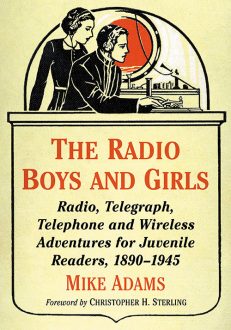The Radio Boys and Girls
Radio, Telegraph, Telephone and Wireless Adventures for Juvenile Readers, 1890–1945
$39.95
In stock
About the Book
Series fiction about wireless and radio was a popular genre of young adult literature at the turn of the 20th century and an early form of social media. Before television and the Internet, books about plucky youths braving danger and adventure with the help of wireless communication brought young people together. They gathered in basements to build crystal sets. They built transmitters and talked to each other across neighborhoods, cities and states. By 1920, there was music on the air and boys and girls tuned in on homemade radios, often inspired by their favorite stories.
This book analyzes more than 50 volumes of wireless and radio themed fiction, offering a unique perspective on the world presented to young readers of the day. The values, attitudes, culture and technology of a century ago are discussed, many of them still debated today, including immigration, gun violence and guns on campus, race, bullying and economic inequality.
About the Author(s)
Bibliographic Details
Mike Adams
Format: softcover (7 x 10)
Pages: 240
Bibliographic Info: 86 photos, notes, bibliography, index
Copyright Date: 2016
pISBN: 978-1-4766-6354-8
eISBN: 978-1-4766-2345-0
Imprint: McFarland
Table of Contents
Acknowledgments vi
Foreword by Christopher H. Sterling 1
Preface 3
Introduction 5
Reading and Defining Juvenile Fiction 9
1. The Radio Century 13
The Four Eras 13 • The First Era—Wired Communication 14 • The Second Era—Wireless Communication 16 • The Third Era—Transition from Wireless to Radio 17 • The Fourth Era and the Importance of 1922 17
2. The Writers of Juvenile Fiction 26
The Stratemeyer Syndicate 26 • A Ghost Story 32 • The Press, the Preachers, the Professors 35 • John Trowbridge 35 • Horatio Alger, Jr. 36 • H. Irving Hancock 37 • John Henry Goldfrap 38 • Howard Garis 38 • Richard Bonner 39 • James R. Driscoll 39 • L.P. Wyman 40 • Wayne Whipple and S.F. Aaron 40 • James Craig 41 • A. Hyatt Verrill 41 • J.W. Duffield 42 • Gerald Breckenridge 42 • Publishers 44 • Illustrations 46
3. The First Era: Telegraph and Telephone Fiction 48
The Electrical Boy 49 • Three Boys on an Electrical Boat 52 • Bound to Be an Electrician 57 • Telegraph Tom’s Venture 61 • Tom the Telephone Boy 63 • The Telegraph Boy 66 • The Boy Scout Electricians; or, The Hidden Dynamo 70
4. The Second Era: Wireless 74
The Story of a Wireless Telegraph Boy 74 • The Motorboat Club and the Wireless 77 • Tom Swift and His Wireless Message 80 • The Boys of the Wireless 85 • Bert Wilson, Wireless Operator 90 • The Motor Rangers Wireless Station 95 • The Ocean Wireless Boys on the Atlantic 100
5. The Third Era: The Transition to Radio 104
The Talking Wireless 104 • The Boy Inventors’ Radio Telephone 104 • The Brighton Boys in the Radio Service 108 • The Radio Detectives 113 • The Radio Boys in the Secret Service 116 • The Radio Boys Under the Sea 120 • The Golden Boys Rescued by Radio 123 • Radio Boys Loyalty 126 • The Radio-Phone Boys: Curlie Carson Listens In 131
6. The Fourth Era (I): The Syndicate Boys and Girls 136
The Radio Boys and Radio Girls 136 • The Radio Boys’ First Wireless 137 • The Radio Boys at Ocean Point 141 • The Radio Boys at the Sending Station 146 • The Radio Girls of Roselawn 150 • The Radio Girls on the Program 155 • The Radio Girls on Station Island 158
7. The Fourth Era (II): The Breckenridge Radio Boys 164
The Breckenridge Radio Boys Series 164 • The Radio Boys on the Mexican Border 164 • The Radio Boys on Secret Service Duty 172 • The Radio Boys with the Border Patrol 176 • The Radio Boys as Soldiers of Fortune 180 • The Radio Boys with the Air Patrol 184
8. Post–Depression Era Radio Stories 191
Janet Hardy in Radio City 192 • The Bobbsey Twins in a Radio Play 195 • • Calling W1XYZ: Jimmy Kean and the Radio Spies 197 • Four Girls and a Radio 199 • The Short Wave Mystery 202
9. Summary and Conclusions 207
The First Era—Electricity and Wired Communications, 1890–1910 207 • The Second Era—Wireless Communication Saves Ships at Sea, 1912–1917 209 • The Third Era—Transition from Code to Radiotelephone, 1915–1920 211 • The Fourth Era—Broadcasting and the Radio Hobbyists, 1922–1930 213
Chapter Notes 221
Bibliography 225
Index 227
Book Reviews & Awards
- “Finally, Professor Adams has given us a book everyone who ever worked around a microphone should read and share with a young person, because it is a profound joy and comfort, and reflects the power and glory of an earlier America and radio’s rile in carrying that banner”—Broadcast Legends
- “Well illustrated with book and magazine covers and technical diagrams of radios that should delight engineers, young and old”—Dime Novel Round Up
- “Very enjoyable, informative and well-written”—Antique Wireless Association Journal
- “Lots of fun period illustrations that will interest any fan of bygone radio topics.”—Radio World
- “More complete than any previous published work on the subject…read the book”—Glendale Daily Planet
- “Excellent…well-illustrated…radio amateurs and radio buffs with an appreciation of history and society will enjoy this one”—ARRL, the national association for Amateur Radio
- “Brings back to life an entire genre of children’s books about electrical communication”—Communications Booknotes Quarterly





